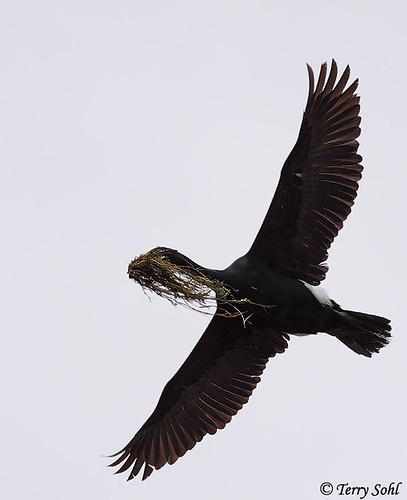tags: Pelagic Cormorant, Phalacrocorax pelagicus, birds, mystery bird, bird ID quiz
[Mystery bird] Pelagic Cormorant, Phalacrocorax pelagicus, photographed at Haystack Rock, Cannon Beach, Oregon. It is taking nesting materials back to the rock, where many of these birds were busy nesting. [I will identify this bird for you in 48 hours]
Image: Terry Sohl, 8 June 2009 [larger view]
Photo taken with a Canon 50D, 400 5.6L lens.
Please name at least one field mark that supports your identification.
More like this
This is a summary of several of the better books I’ve had the opportunity to review here, organized in general categories.
tags: birds, mystery bird, bird ID quiz
tags: conservation, endangered species,
Family Guy, S07E02 'I Dream of Jesus':
Peter: Brian, can I see that paper for a sec?
(Brian gives Peter the paper. Peter peruses the paper.)
Peter: Huh... that's odd... I thought that would big news.


I'm going to call that a pelagic cormorant. It's clearly a cormorant from the overall silhouette (despite the clever bit with the nest material) , and according to the trusty Sibley, pelagic is the only cormorant I'd expect to see nesting in Oregon with those white flank patches.
Ditto. Pelagic Cormorant.
White marking on side. Rounded top of head. Only large wingspan, black colored ocean shore nesting based bird I can picture in the Northwest and Pacific Coast region.
That was fun. In all of my years in traditional educational environments we never did this.
I wonder where the 'world' of our education will be in the future? Maybe, we will get to redirect public funds to more broad based, passionate teachers...
I know who I would want to take some science classes from!!!
One more field mark -- the straight neck. Double-crested, Neotropic and Great Cormorants all fly with their necks kinked to one side. I only bother mentioning this to rule out the incredibly unlikely possibility of a Great Cormorant attempting to nest in Oregon. (Actually, I guess the statement that "many of these birds were nesting" would rule that out already. Oh, well ...)
By the way, it seems that June 9 is a bit late for nest-building in a large resident species -- anyone out there from the NW know if this is typical timing?